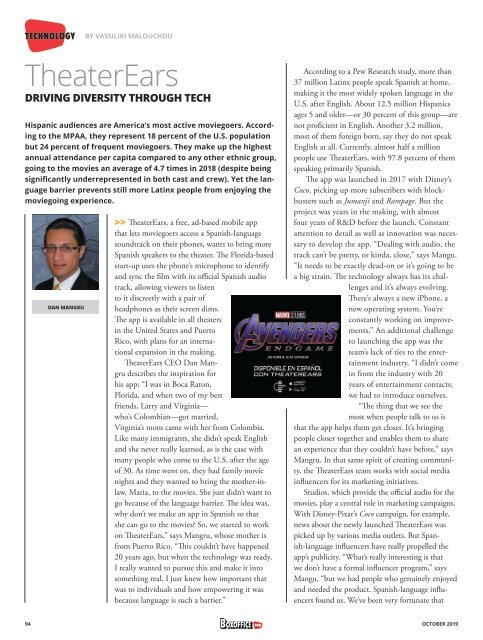Boxoffice Pro - October 2019
The Official Magazine of the National Association of Theatre Owners
The Official Magazine of the National Association of Theatre Owners
Create successful ePaper yourself
Turn your PDF publications into a flip-book with our unique Google optimized e-Paper software.
TECHNOLOGY<br />
BY VASSILIKI MALOUCHOU<br />
TheaterEars<br />
DRIVING DIVERSITY THROUGH TECH<br />
Hispanic audiences are America’s most active moviegoers. According<br />
to the MPAA, they represent 18 percent of the U.S. population<br />
but 24 percent of frequent moviegoers. They make up the highest<br />
annual attendance per capita compared to any other ethnic group,<br />
going to the movies an average of 4.7 times in 2018 (despite being<br />
significantly underrepresented in both cast and crew). Yet the language<br />
barrier prevents still more Latinx people from enjoying the<br />
moviegoing experience.<br />
DAN MANGRU<br />
>> TheaterEars, a free, ad-based mobile app<br />
that lets moviegoers access a Spanish-language<br />
soundtrack on their phones, wants to bring more<br />
Spanish speakers to the theater. The Florida-based<br />
start-up uses the phone’s microphone to identify<br />
and sync the film with its official Spanish audio<br />
track, allowing viewers to listen<br />
to it discreetly with a pair of<br />
headphones as their screen dims.<br />
The app is available in all theaters<br />
in the United States and Puerto<br />
Rico, with plans for an international<br />
expansion in the making.<br />
TheaterEars CEO Dan Mangru<br />
describes the inspiration for<br />
his app: “I was in Boca Raton,<br />
Florida, and when two of my best<br />
friends, Larry and Virginia—<br />
who’s Colombian—got married,<br />
Virginia’s mom came with her from Colombia.<br />
Like many immigrants, she didn’t speak English<br />
and she never really learned, as is the case with<br />
many people who come to the U.S. after the age<br />
of 30. As time went on, they had family movie<br />
nights and they wanted to bring the mother-inlaw,<br />
Maria, to the movies. She just didn’t want to<br />
go because of the language barrier. The idea was,<br />
why don’t we make an app in Spanish so that<br />
she can go to the movies? So, we started to work<br />
on TheaterEars,” says Mangru, whose mother is<br />
from Puerto Rico. “This couldn’t have happened<br />
20 years ago, but when the technology was ready,<br />
I really wanted to pursue this and make it into<br />
something real. I just knew how important that<br />
was to individuals and how empowering it was<br />
because language is such a barrier.”<br />
According to a Pew Research study, more than<br />
37 million Latinx people speak Spanish at home,<br />
making it the most widely spoken language in the<br />
U.S. after English. About 12.5 million Hispanics<br />
ages 5 and older—or 30 percent of this group—are<br />
not proficient in English. Another 3.2 million,<br />
most of them foreign born, say they do not speak<br />
English at all. Currently, almost half a million<br />
people use TheaterEars, with 97.8 percent of them<br />
speaking primarily Spanish.<br />
The app was launched in 2017 with Disney’s<br />
Coco, picking up more subscribers with blockbusters<br />
such as Jumanji and Rampage. But the<br />
project was years in the making, with almost<br />
four years of R&D before the launch. Constant<br />
attention to detail as well as innovation was necessary<br />
to develop the app. “Dealing with audio, the<br />
track can’t be pretty, or kinda, close,” says Mangu.<br />
“It needs to be exactly dead-on or it’s going to be<br />
a big strain. The technology always has its challenges<br />
and it’s always evolving.<br />
There’s always a new iPhone, a<br />
new operating system. You’re<br />
constantly working on improvements.”<br />
An additional challenge<br />
to launching the app was the<br />
team’s lack of ties to the entertainment<br />
industry. “I didn’t come<br />
in from the industry with 20<br />
years of entertainment contacts;<br />
we had to introduce ourselves.<br />
“The thing that we see the<br />
most when people talk to us is<br />
that the app helps them get closer. It’s bringing<br />
people closer together and enables them to share<br />
an experience that they couldn’t have before,” says<br />
Mangru. In that same spirit of creating community,<br />
the TheaterEars team works with social media<br />
influencers for its marketing initiatives.<br />
Studios, which provide the official audio for the<br />
movies, play a central role in marketing campaigns.<br />
With Disney-Pixar’s Coco campaign, for example,<br />
news about the newly launched TheaterEars was<br />
picked up by various media outlets. But Spanish-language<br />
influencers have really propelled the<br />
app’s publicity. “What’s really interesting is that<br />
we don’t have a formal influencer program,” says<br />
Mangu, “but we had people who genuinely enjoyed<br />
and needed the product. Spanish-language influencers<br />
found us. We’ve been very fortunate that<br />
94 OCTOBER <strong>2019</strong>

















